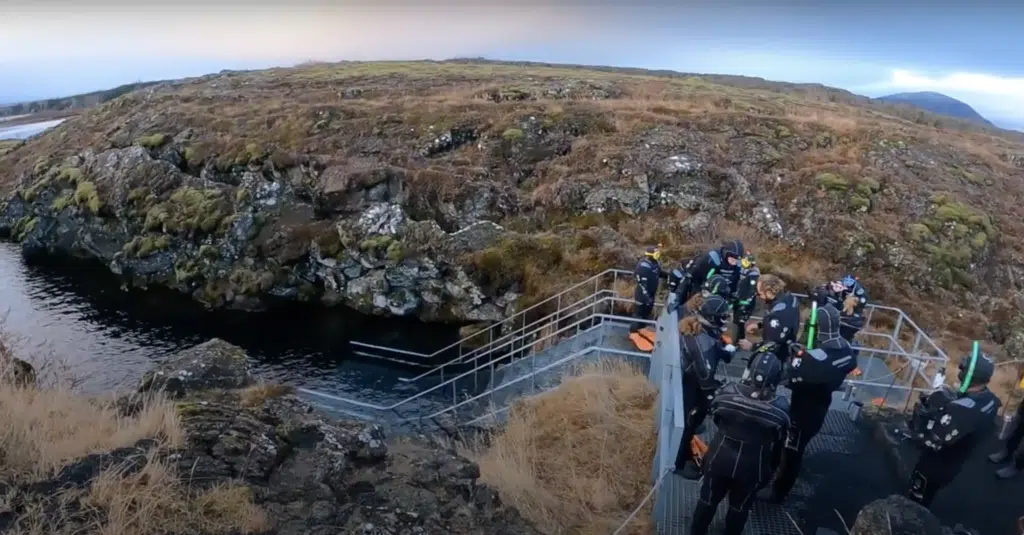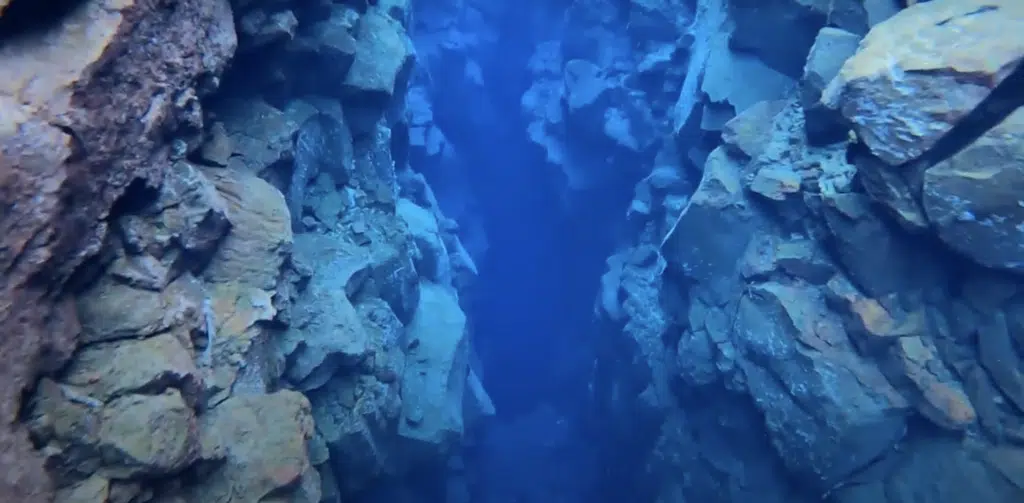Snorkeling Between Tectonic Plates in Iceland – A Must Do!
This post may contain affiliate links, which means I’ll receive a commission if you purchase through my link, at no extra cost to you.
Last week we spent the Thanksgiving holiday on an 8-day trip to Iceland, swapping out turkey dinner for lamb and fish. It was truly one of the most incredible trips I’ve ever taken – we literally did a once in-a-lifetime experience every single day. I take notes on my phone as we travel so I don’t forget anything and I’m pretty sure I wrote enough to publish a short book, so I will be breaking Iceland up across the next several blog posts.

To start off this Iceland series, this blog will focus solely on our experience snorkeling between the North American and European tectonic plates at Silfra Fissure in Þingvellir National Park (FYI the Þ is pronounced like “th”). In fact, it’s the only place in the world where you can snorkel between tectonic plates! We did this on day 2 of our trip, so we got off to a strong start.
I’d seen snorkeling at Silfra come up multiple times in my extensive research and planning of this trip and was surprised to find that it is a year-round activity. Visiting in November wasn’t all that different than visiting in the summer because the water is a pretty constant ~35 degrees Fahrenheit (~2 degrees Celsius) year-round since it is glacial melt water that flows underground to reach the fissure. This pure water is also what makes for such great snorkeling, as you have clear views all the way down.
Preparing
After a ~50 min drive from out hotel in Reykjavik, we pulled up to the address Google Maps had sent us to and found all the vans from the various tour companies.The actual parking lot for cards is just a couple hundred yards further down the road and you have to walk from there to the vans. There are free bathrooms located at both parking lots and since you’re zipped into a dry suit for approximately 2 hours, you should definitely make sure to pay them a visit. I purposely didn’t drink any water before the tour just to be safe.
As soon as we arrived, we found the van of the tour company we’d booked through (Adventure.IS) and they immediately started getting us the equipment we needed and providing instructions on how to put everything on. Step 1 was to take off our outer layers so that we were just wearing our wool thermal socks, pants, and long sleeve shirt, leaving our warm outer layers in a dry bag. It had been raining on our drive to the park but thankfully had stopped by the time we were getting changed or it would have felt much colder. Then we quickly put on a jumpsuit to help keep us warm (because it was only about 40 degrees Fahrenheit outside) before putting on the dry suit. The water is so cold that instead of wearing a traditional neoprene wet suit, you actually put on a dry suit instead that seals around the wrists and neck (the shoes are built into the suit) to keep you dry on the inside.
They then handed us neoprene gloves and hoods – these did let the water in and get wet, but still kept us much warmer than without them. The guides checked to ensure the seals at our wrists and neck were tight and added extra rubber bands if necessary to prevent any water from getting in. They also gave us a mask, snorkel, and flippers. The process of getting all our gear and then a guide was a bit chaotic with multiple tour operators running around to help everyone but manageable.
Once we were all suited up, we were somewhat randomly split up into groups of 6 people with each guide and went through a briefing. Then walked a couple hundred yards along the path to the entrance to the fissure where there were stairs leading into the water.

Getting In
For safety purposes, each group of 6 had to wait their turn behind the other groups and could only get in the water once the group in front of them had passed a certain point. This luckily didn’t take too long and our guide filled the time by taking pictures of everyone on his GoPro (which were included with the tour and accessible online afterwards).
When we first got in the water, I was surprised by the immediate tightening of my suit around my legs as the water pressure pushed the air higher into the parts of my suit that were above the water. It wasn’t painful, just a light pressure around my feet and calves. Once I fully got into the water, it balanced out more evenly. Because there was air in the dry suit, we didn’t have to worry at all about sinking – the suits were incredibly buoyant. In fact, it would be hard to dive down and the guide discouraged us from trying because extra movement of the hands and neck increased the chances of water entering the suit. Instead, we just kept our hands still and propelled ourselves forward by frog kicking our feet.
The first section of the fissure is a make-or-break point, because once you pass beyond that, there’s no chance to bail and get out until the end. We did end up seeing one guy bail in this first zone and get pulled out before we got in. There is also a slight current so you don’t have to put much effort into paddling, but there were a couple important places to ensure we turned at so we didn’t drift out to the open waters beyond the fissure.
The water was definitely cold, but I’d expected to be shaking and for my teeth to be chattering, and it thankfully it wasn’t that cold. In fact, my very first thought after getting in was how surprisingly comfortable I was and that remained true the whole time.

Snorkeling
The exact length of your time in the water can vary depending on how fast you go and if you choose to get out immediately at the end or spend an extra couple of minutes exploring the area around the exit stairs, but it takes roughly 45 minutes (the bulk of the estimated 3-hour tour time is really spent getting the gear on and off).
When you put your head under the water, you are immediately immersed in beautiful underwater views all the way to the bottom with the rock walls of either continent on either side. I found myself drifting close to one side or another and had to focus and put in some effort to keep myself more centered and get the best view. In some areas, the rocks are very high and you can touch them as you float above them (in a couple cases I used the rocks to help propel myself forward). We were warned that our lips would become numb in the water, which definitely happened and made it difficult to keep a tight seal around the mouthpiece, so more than once I found water in my snorkel. A couple times I drained it above water, but more often than not I took advantage of snorkeling in fresh water and just swallowed it.
There are no fish in Silfra, but there were some algae growing on the rocks. The star of the show here isn’t the biodiversity but rather the geology and it was stunning. The deepest and most remarkable area of the path was called “The Cathedral” and they had fun names for other sections as well.
Our guide used his GoPro to take pictures of us in the water and we also brought our own GoPro to capture the experience, so we had fun shooting footage of the fissure.
At the end of the snorkeling path, we had the option to head straight for the stairs to get out or we could go to either side of the stairs for a few minutes to continue exploring. To the left was “Mini Silfra” where it got deep again and resembled the Cathedral. To the right was what they had dubbed “the Bahamas” because there was white sand along the bottom and if it weren’t for the barely-above-freezing water and lack of fish you might think you were snorkeling in a tropical island. We took our time and explored, but only had until the next group behind us arrived before we had to get out.
[RELATED: Snorkeling with Orcas in Norway]
Afterwards
The guides helped us out of the water and then we walked back to the vans where we were helped out of the dry suits (you have very limited range of motion in the suit and it zips in the back so you absolutely need help getting it off). Once all our gear was put away and our warm clothes were back on, we were given hot chocolate and cookies to warm up.
As we were getting changed, I noticed a girl from another group had emerged soaking wet and I felt so bad for her. I am guessing her suit had a leak in it, which likely would have ruined the experience for me, but she had stuck it out through the whole tour.
Our guide had us take a picture of the link to the online photos from a single business card he had. We had left our phones in the car (which was unnecessary), but were able to take a picture on the GoPro and access them that night. They didn’t send an email or anything with this link, so taking a picture was the only opportunity we had to find them.
As we left, I think we may have accidentally not paid for parking or it was free. I didn’t see any signs for parking or a kiosk, but the internet had said it was paid parking, so just watch out.
Overall Impression
I was fairly nervous going into this excursion because I thought I’d be too cold and uncomfortable to have fun and I thought my gag reflex would be triggered by the suit or snorkel causing me to choke and have issues. The guy who bailed at the very beginning of the fissure also didn’t give me a lot of confidence going in. Thankfully all my worries were unfounded and it was so much fun – I was really sad when it was time to get out of the water. I cannot recommend this enough to anyone visiting Iceland!
You can alternatively book a scuba diving tour instead of snorkeling and go down deep into the fissure, but you may need a scuba certification for that.
If you are watching the current season of the Amazing Race, the previews for tonight’s upcoming episode shows the contestants snorkeling in Silfra as they race across Iceland. We did book and do our excursion before we saw the clip, so we weren’t just copying them, but I am glad I have the same taste in activities as the producers of one of my favorite shows.
If you want to see more of our experience, we put together a little vlog about it. You can watch that here.
You may also like:

